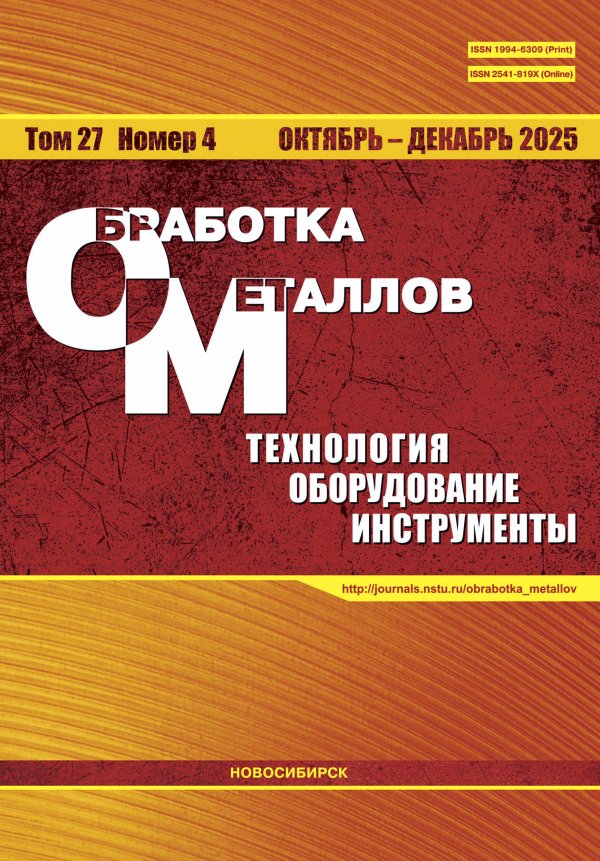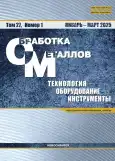Разработка и исследование композиционных материалов из акрилата с ПЭЭК для изготовления имплантатов тазобедренного сустава методом аддитивного производства (DLP 3D-печать)
- Авторы: Дама Й.1, Джоги Б.1, Паваде Р.1, Пал Ш.1, Гаиквад Й.1
-
Учреждения:
- Выпуск: Том 27, № 1 (2025)
- Страницы: 172-191
- Раздел: МАТЕРИАЛОВЕДЕНИЕ
- URL: https://journal-vniispk.ru/1994-6309/article/view/290295
- DOI: https://doi.org/10.17212/1994-6309-2025-27.1-172-191
- ID: 290295
Цитировать
Аннотация
Ключевые слова
Об авторах
Й. Дама
Email: yogirajdama@dbatu.ac.in
ORCID iD: 0009-0008-5404-4347
Технологический университет доктора Бабасахеба Амбедкара, Лонере, Райгад, Махараштра, 402103, Индия, yogirajdama@dbatu.ac.in
Б. Джоги
Email: bfjogi@dbatu.ac.in
ORCID iD: 0000-0003-2099-7533
профессор, Технологический университет доктора Бабасахеба Амбедкара, Лонере, Райгад, Махараштра, 402103, Индия, bfjogi@dbatu.ac.in
Р. Паваде
Email: rspawade@dbatu.ac.in
ORCID iD: 0000-0001-7239-625X
доцент, Технологический университет доктора Бабасахеба Амбедкара, Лонере, Райгад, Махараштра, 402103, Индия, rspawade@dbatu.ac.in
Ш. Пал
Email: shibampal123456@gmail.com
ORCID iD: 0000-0002-3681-5039
канд. хим. наук, Национальная химическая лаборатория CSIR, Пашан, Пуна, Махараштра, 411008, Индия, shibampal123456@gmail.com
Й. Гаиквад
Email: gaikwadyogesh259@gmail.com
ORCID iD: 0009-0003-3211-0861
канд. хим. наук, Национальная химическая лаборатория CSIR, Пашан, Пуна, Махараштра, 411008, Индия, gaikwadyogesh259@gmail.com
Список литературы
- The needs of current implant technology in orthopaedic prosthesis biomaterials application to reduce prosthesis failure rate / J.R. Ahmad, F.M. Aldo, S. Ifran, K. Tri, W. Yudan // Journal of Nanomaterials. – 2016. – Art. 5386924. – doi: 10.1155/2016/5386924.
- Garcia E., Fernandez A., Martin L. Comparative analysis of traditional and advanced materials for hip joint implants // Materials Science and Engineering C. – 2020. – Vol. 112. – P. 110857. – doi: 10.1080/17453674.2018.1427320.
- Developments of PEEK (Polyetheretherketone) as a biomedical material: a focused review / S. Verma, N. Sharma, S. Kango, S. Sharma // European Polymer Journal. – 2021. – Vol. 147. – P. 110295. – doi: 10.1016/j.eurpolymj.2021.110295.
- PEEK for oral applications: recent advances in mechanical and adhesive properties / C. Luo, Y. Liu, B. Peng, M. Chen, Z. Liu, Z. Li, H. Kuang, B. Gong, Z. Li, H. Sun // Polymers. – 2023. – Vol. 15 (2). – doi: 10.3390/polym15020386.
- D printing for hip implant applications: a review / O. Obinna, I. Stachurek, B. Kandasubramanian, J. Njuguna // Polymers. – 2020. – Vol. 12 (11). – P. 2682. – doi: 10.3390/polym12112682.
- Влияние направления печати на характер износа PLA-биоматериала, полученного методом FDM: исследование для имплантата тазобедренного сустава / Й.Б. Дама, Б.Ф. Джоги, Р. Паваде, А.П. Кулкарни // Обработка металлов (технология, оборудование, инструменты). – 2024. – Т. 26, № 4. – С. 19–40. – doi: 10.17212/1994-6309-2024-26.4-19-40.
- Rapid construction of polyetheretherketone (PEEK) biological implants incorporated with brushite (CaHPO4·2H2O) and antibiotics for anti-infection and enhanced osseointegration / Z. Xue, Z. Wang, A. Sun, J. Huang, W. Wu, M. Chen, X. Hao, Z. Huang, X. Lin, S. Weng // Materials Science & Engineering: C. – 2020. – Vol. 111. – P. 110782. – doi: 10.1016/j.msec.2020.110782.
- Wear mechanism and debris analysis of PEEK as an alternative to CoCrMo in the femoral component of total knee replacement / X. Zhang, T. Zhang, K. Chen, H. Xu, C. Feng, D. Zhang // Friction. – 2023. – Vol. 11 (10). – P. 1845–1861. – doi: 10.1007/s40544-022-0700-z.
- Bioactive PEEK: surface enrichment of vitronectin-derived adhesive peptides / L. Cassari, A. Zamuner, G.M.L. Messina, M. Marsotto, H. Chen, G. Gonnella, T. Coward, C. Battocchio, J. Huang, G. Iucci, G. Marletta, L. Di Silvio, M. Dettin // Biomolecules. – 2023. – Vol. 13 (2). – P. 246. – doi: 10.3390/biom13020246.
- Yu D., Lei X., Zhu H. Modification of polyetheretherketone (PEEK) physical features to improve osteointegration // Journal of Zhejiang University-Science B. – 2022. – Vol. 23 (3). – P. 189–203. – doi: 10.1631/jzus.B2100622.
- D-printed PEEK/silicon nitride scaffolds with a triply periodic minimal surface structure for spinal fusion implants / X. Du, S. Ronayne, S.S. Lee, J. Hendry, D. Hoxworth, R. Bock, S.J. Ferguson // ACS Applied Bio Materials. – 2023. – Vol. 6 (8). – P. 3319–3329. – doi: 10.1021/acsabm.3c00383.
- Tailoring the biologic responses of 3D printed PEEK medical implants by plasma functionalization / X. Han, N. Sharma, S. Spintzyk, Y. Zhou, Z. Xu, F.M. Thieringer, F. Rupp // Dental Materials. – 2022. – Vol. 38 (7). – P. 1083–1098. – doi: 10.1016/j.dental.2022.04.026.
- Dama Y.B., Jogi B.F., Pawade R.S. Application of nonlinear analysis in evaluating additive manufacturing processes for engineering design features: a study and recommendations // Communications on Applied Nonlinear Analysis. – 2024. – Vol. 31 (1s). – doi: 10.52783/cana.v31.559.
- Explainable AI techniques for comprehensive analysis of the relationship between process parameters and material properties in FDM-based 3D-printed biocomposites / N. Kharate, P. Anerao, A. Kulkarni, M. Abdullah // Journal of Manufacturing and Materials Processing. – 2024. – Vol. 8 (4). – P. 171. – doi: 10.3390/jmmp8040171.
- A comprehensive mechanical characterization of as-printed and saliva soaked 3D printed PEEK specimens for low-cost dental implant applications / K.U.K. Reddy, P.C. Verma, A. Rathi, P. Saravanan // Materials Today Communications. – 2023. – Vol. 36. – P. 106438. – doi: 10.1016/j.mtcomm.2023.106438.
- Preclinical evaluation of a mini-arthroplasty implant based on polyetheretherketone and Ti6AI4V for treatment of a focal osteochondral defect in the femoral head of the hip / W. Zhang, Z. Yuan, X. Meng, J. Zhang, T. Long, Z. Yaochao, C. Yang, R. Lin, B. Yue, Q. Guo, Y. Wang // Biomedical Materials. – 2020. – Vol. 15 (5). – P. 055027. – doi: 10.1088/1748-605x/ab998a.
- D-printed PEEK/silicon nitride scaffolds with a triply periodic minimal surface structure for spinal fusion implants / X. Du, S. Ronayne, S.S. Lee, J. Hendry, D. Hoxworth, R. Bock, S.J. Ferguson // ACS Applied Bio Materials. – 2023. – Vol. 6 (8). – P. 3319–3329. – doi: 10.1021/acsabm.3c00383.
- Design and biomechanical verification of additive manufactured composite spinal cage composed of porous titanium cover and PEEK body / K.M. Lim, T.H. Park, S.J. Lee, S.J. Park // Applied Sciences. – 2019. – Vol. 9 (20). – P. 4258. – doi: 10.3390/app9204258.
- Comparative analysis of drop impact resistance for different polymer-based materials used for hearing aid casing / A. Gosavi, A. Kulkarni, Y. Dama, A. Deshpande, B. Jogi // Materials Today: Proceedings. – 2022. – Vol. 49. – P. 2433–2441. – doi: 10.1016/j.matpr.2021.09.519.
- Effect of porous orthopaedic implant material and structure on load sharing with simulated bone ingrowth: a finite element analysis comparing titanium and PEEK / R.D. Carpenter, B.S. Klosterhoff, F.B. Torstrick, K.T. Foley, J.K. Burkus, C.S. Lee, K. Gall, R.E. Guldberg, D.L. Safranski // Journal of the Mechanical Behavior of Biomedical Materials. – 2018. – Vol. 80. – P. 68–76. – doi: 10.1016/j.jmbbm.2018.01.017.
- Virpe K., Deshpande A., Kulkarni A. A review on tribological behavior of polymer composite impregnated with carbon fillers // AIP Conference Proceedings. – 2020. – Vol. 2311 (1). – doi: 10.1063/5.0035408.
- Experimental investigation of dry sliding wear behavior of jute/epoxy and jute/glass/epoxy hybrids using Taguchi approach / A. Paturkar, A. Mache, A. Deshpande, A. Kulkarni // Materials Today: Proceedings. – 2018. – Vol. 5 (11). – P. 23974–23983. – doi: 10.1016/j.matpr.2018.10.190.
- Satkar A.R., Mache A., Kulkarni A. Numerical investigation on perforation resistance of glass-carbon/epoxy hybrid composite laminate under ballistic impact // Materials Today: Proceedings. – 2022. – Vol. 59 (1). – P. 734–741. – doi: 10.1016/j.matpr.2021.12.464.
- Чинчаникар С. Моделирование характеристик износа при скольжении композиционного материала на основе политетрафторэтилена (ПТФЭ), армированного углеродным волокном, в паре трения с SS304 (12Х18Н10Т) // Обработка металлов (технология, оборудование, инструменты). – 2022. – Т. 24, № 3. – С. 40–52. – doi: 10.17212/1994-6309-2022-24.3-40-52.
- Kanitkar Y.M., Kulkarni A.P., Wangikar K.S. Investigation of flexural properties of glass-Kevlar hybrid composite // European Journal of Engineering and Technology Research. – 2018. – Vol. 1 (1). – P. 25–29. – doi: 10.24018/ejeng.2016.1.1.90.
- Pal S., Gaikwad Y., Asha S.K. Room temperature photocurable PEEK polymer formulations for high-performance 3D printing applications // ACS Applied Engineering Materials. – 2024. – Vol. 2 (6). – P. 1450–1459. – doi: 10.1021/acsaenm.4c00275.
- Biochar-reinforced PLA composite for fused deposition modeling (FDM): a parametric study on mechanical performance / P. Anerao, A. Kulkarni, Y. Munde, A. Shinde, O. Das // Composites Part C: Open Access. – 2023. – Vol. 12. – P. 100406. – doi: 10.1016/j.jcomc.2023.100406.
- Three-dimensional polyethylene wear of a press-fit titanium prosthesis / P.A. Devane, J.G. Horne, K. Martin, G. Coldham, B. Krause // The Journal of Arthroplasty. – 1997. – Vol. 12 (3). – doi: 10.1016/S0883-5403(97)90021-8.
Дополнительные файлы







